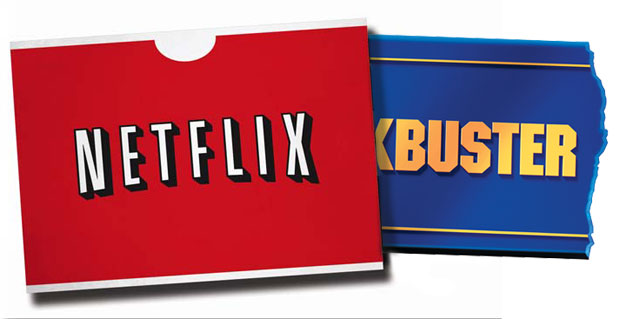Will Lifesize and Polycom be the Next Blockbuster Video?
In 2004 Blockbuster Video had 60,000 employees, 9,000 video stores and did 6 Billion, (yes, with a “B”), dollars in revenue. By 2010 they were bankrupt. What happened?
Netflix.
The strangest part of the whole thing though is that Netflix never wanted or intended to be in the DVD business long term. You don’t have to look far past their name to know what Netflix’s long term goal was. To be the leading online, cloud-based, streaming video service. That is exactly what they are today, to the tune of over 50 million worldwide online subscribers. But how did they get there and how did they kill Blockbuster in the process?
Netflix knew that building the online infrastructure they needed and paying for the licensing for the movie library they wanted to build was going to be extremely expensive. They also knew that they would have to create a paradigm shift in the minds of the movie consumer, who was used to going to a video store every week for their entertainment.
The Catch 22 was only a large online library would attract the number of users needed to make the money needed to build a large online library. It was a circular problem.
They also knew that the Blockbuster customer was their target. This was the revenue stream they needed to start to capture in order to start building up their coffers for the work ahead. With Blockbuster having both the mind and market share, how would Netflix take these customers? They decided to exploit the weaknesses in the Blockbuster business model.
There were a couple major problems with the Blockbuster model. One was that it was extremely cost heavy. DVDs were cheap, but 9000 stores and 60,000 employees were not. Blockbuster was also heavily dependent on one habit of their customers to stay afloat. That was the habit of procrastination. Late fees were a huge source of revenue for Blockbuster. The inability of their customers to return movies on time was money in the bank and really accounted for a large amount of their profits.
Netflix built an inventory of DVDs and offered a subscription based service to deliver movies to people’s homes through the mail. Their inventory and library were not as big, and they didn’t even guarantee you’d get your first choice of movies, but rather just something from your pre-selected queue. So why would people switch? Why would they sacrifice choosing the exact movie they wanted that night and wait several days to get it?
The answer is that customers knew that they were getting killed on late fees. With Netflix, they could get as many movies as they wanted, 2 at a time, and could keep them as long as they wanted and wouldn’t incur any late fees. So Netflix banked on customers being self aware of their bad habits. Netflix also banked on those bad habits continuing. The same procrastination played well to Netflix’s advantage as if people didn’t return movies very consistently, they didn’t have to keep as much inventory. No one was really maxing out the “all you can watch” promise.
With the Netflix model of no brick and mortar stores and mailing DVDs, the profit margins on DVD subscriptions was 47% It was highly profitable, and Netflix started putting those profits into their online library and infrastructure. Their ordering model had gotten people used to the idea of going online to select movies, so when they added the ability to watch a movie now on your computer, people started to try it. Now Netflix was starting to change their customers’ expectation of how they could watch movies. They continued to offer both services under one subscription as broadband proliferated and they continued using the DVD profits to finance their online project. Not many people wanted to watch movies on their PC, so Netflix started to partner with companies like Roku and also created apps for web enabled TVs, AVRs, and Blu-Ray Players as well as the major gaming platforms and mobile devices. This extended the reach of the online content from the PC back to the TV and even to portable devices. Now people were starting to get hooked.
This is where Netflix made a very interesting decision. They decided to break the DVD service and the streaming service into separate subscriptions. They made their users make a choice. Did they like the wider selection and consistent quality of the DVD service despite the time delay or did they prefer to get movies now, even if the titles they wanted took longer to become available and they may be delivered at varying quality based on the ISPs speed? It caused quite a backlash at first, but Netflix really didn’t lose many subscribers. The majority of subscribers chose the online service, which had much lower margins than the DVD counterpart. So why would Netflix purposefully start to kill the most profitable part of their business while they still led the market?
They knew that the DVD rental curve was about to decline, and that online based content was the next evolution. Hardware was about to be dead and services were about to be the new profit center. They jumped the curve and beat the competition to the next market.
The gamble worked. DVD subscribers continued to pay for the improvements in the online system. Profits from online finally eclipsed the DVD profits as of a couple years ago, and today they continue to grow comparatively. In fact, there are only 6 million DVD subscribers left, compared to the 50 million online Netflix users.
Blockbuster tried to offer DVDs by mail as a reaction to Netflix’s rise and also changed their late fee policies, (the new policy was marketed as no late fees, but they charged customers for the whole movie after a few days, which didn’t go over well either), and even started an online service as well. But it was an ancillary strategy that came too late. In the end, they couldn’t catch up to take their market back, nor could they compete in the new one online.
Which brings me to Lifesize and Polycom and the hard codec. Have they held onto the hardware business model too long? Of course margins are high in proprietary codecs but are these companies, as Peter Drucker would describe it, slaughtering tomorrow’s opportunity on the altar of yesterday?
At one point in time the hard codec had some unique advantages in quality and security. However, with products like Vaddio’s Easy USB and HuddleStation, it is fairly easy today to add a high end look and feel to VTC while still leveraging the cost of the soft codecs like Lync, Skype, Google Hangouts, etc.
IT managers are now already securing and managing their networks to allow for provisioning of new BYOD and consumer mobile devices, so adding protocols for machines running soft codecs is not as costly as it may have been in the past.
The quality and security gaps are being closed at a fraction of the cost, so the niche for hard codecs is shrinking. Lifesize and Polycom are making the customer choose between a perceived marginal quality increase of their hardware based systems at a premium cost and a low cost cloud based solution. Sound familiar?
The difference is that Netflix was the leader for either solution, and kept the customers regardless of the choice they made.
Now, you may say that Polycom and Lifesize offer some cloud based options as well. Remember that Blockbuster added movies by mail and online streaming as well before they went extinct. Can they catch up to companies like Blue Jeans, Zoom, and Acano whose strategy seems to be cloud first? Are Polycom and Lifesize offering cloud based services as a me too strategy to appease those who want it, or is it their business transition strategy? From the outside it seems like the former. However, I don’t sit in the big room where those discussions are had, so I can’t be sure.
This is where I ask you to start again at the beginning.
Netflix always knew they were going to be a streaming company. Their whole business model was based upon exploiting hardware (DVD subscriptions) to build their online streaming business. They knew that the business model of the past had inherent weaknesses and that they could exploit those weaknesses to steal customers and dominate the very market that they intended to kill while creating one that never existed before. They never wanted to be in the DVD rental business, but they wanted the DVD rental revenues to bankroll their future. It worked.
I think if you read this post critically, you may find several lessons that could be taken to heart in regards to our businesses’ models. All of those lessons entail a popular axiom of today which is
“What got you here today will never be sufficient to get you there tomorrow.”
Food for thought.
Is your integration business buying a Blockbuster franchise in 2004 or are you investing in Netflix before their IPO?






